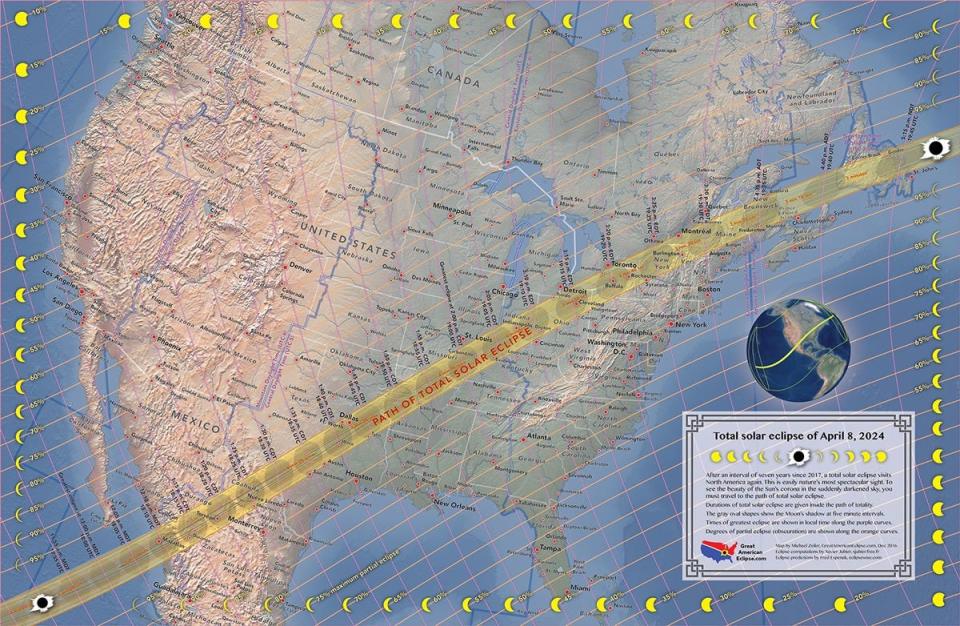Here's where you can watch the next total solar eclipse
A partial solar eclipse happening later this year may be a great time to practice for a total eclipse in April 2024.
An annual solar eclipse will cross North, Central and South America while being visible in all 48 contiguous states, plus Alaska, Oct. 13, according to NASA.gov.
"During an annular eclipse, it is never safe to look directly at the sun without specialized eye protection designed for solar viewing," NASA reminded. "Viewing any part of the bright sun through a camera lens, binoculars, or a telescope without a special-purpose solar filter secured over the front of the optics will instantly cause severe eye injury."
While the Oct. 14 solar eclipse will be a “partial eclipse” for Missouri, a total solar eclipse is slated for April 8, 2024.
The total solar eclipse will start over the South Pacific Ocean before crossing North America and passing over Mexico, the United States and Canada, according to NASA. The first location in continental North America that will experience totality is Mexico’s Pacific coast around 11:07 a.m. PDT.
The path of the eclipse enters the United States in Texas before traveling through the following states: Oklahoma, Arkansas, Missouri, Illinois, Kentucky, Indiana, Ohio, Pennsylvania, New York, Vermont, New Hampshire and Maine.
According to NASA, the total eclipse should begin in Poplar Bluff around 1:56 p.m. CDT.
More:Show me an eclipse: Missouri gears up for spectacular total solar eclipse
The eclipse will enter Canada in Southern Ontario, and continue through Quebec, New Brunswick, Prince Edward Island, and Nova Scotia. The eclipse will exit continental North America on the Atlantic coast of Newfoundland, Canada, at 5:16 p.m. NDT.

"On April 8, 2024, portions of Southeast Missouri will experience more than four minutes of 'totality,' nearly double the length of totality of the 2017 Total Solar Eclipse with all of Missouri experiencing a 'partial eclipse,'" according to a news release from Missouri Eclipse Task Force.
Here are some events focused on the upcoming solar eclipses in Missouri
With several months between now and the partial, there are already events being planned to help Missourians find the best viewing areas and other need-to-know tidbits.
Missouri Eclipse Task Force is hosting a Solar Eclipse Expo in Cape Girardeau July 21 and an all-day expo July 22 at Southeast Missouri State University.
The expo's first day will focus on “Get Ready for the 2023 and 2024 Solar Eclipses” with panelists including a representative from NASA, eclipse expert Fred Espenak, known as Mr. Eclipse, a representative of the Missouri Department of Tourism and a weather expert. The panel discussion will be 6:30-8 p.m. Doors open at 6 p.m. Tickets are free, but seating is limited. A virtual participation option will also be available.
An all-day expo will be July 22 in the Show Me Center on the campus of Southeast Missouri State University in Cape Girardeau. Exhibits, educational stations, two theaters of expert speakers, solar viewing (weather permitting) and door prizes are planned. Doors open at 10 a.m. and close at 5 p.m. Tickets are free, if you pre-register, and $3 at the door.
Visit semoeclipseexpo.org for details.
Sara Karnes is an Outdoors Reporter with the Springfield News-Leader. Follow along with her adventures on Twitter and Instagram @Sara_Karnes. Got a story to tell? Email her at skarnes@springfi.gannett.com.
This article originally appeared on Springfield News-Leader: Here's where you can watch the next total solar eclipse

